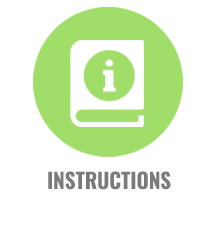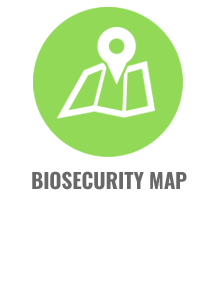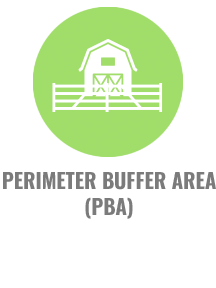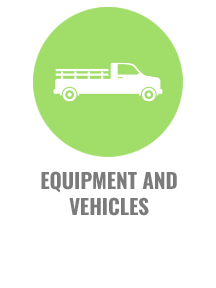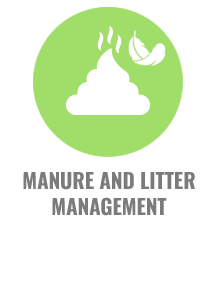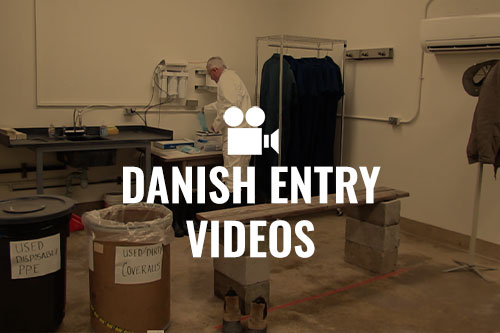Line of Separation
Introduction
Your farm’s enhanced biosecurity plan will include a Line of Separation” (LOS) section that describes the operational barrier separating the cleanest/highest biosecure area on the premises from the less clean areas of the Perimeter Buffer Area (PBA).
Poultry Operations: For poultry farms typically each individual poultry house is surrounded by its own LOS. These houses/areas exist within the Perimeter Buffer Area (PBA) which surrounds the entire operation, not including crop fields. Commonly, employees and visitors change into dedicated, farm-specific PPE (coveralls, boots) when crossing into the PBA from outside the farm. In addition, usually employees and visitors will use footwear disinfection and hand sanitation stations before crossing the LOS into a poultry house.
Dairy Operations: For dairy farms typically cows move from their housing to the milking barn 2-3 times per day. In addition, and manure is collected from free stalls and pens, transported and comingled at a lagoon or composting site. This constant movement of cows and manure makes it difficult, if not impossible, to have heightened biosecurity in housing areas surrounded by a LOS. In this case on a dairy the LOS may be the same as the limit of the PBA.
Premises Maps: In additional to the written description of how the LOS operates during daily operation and enhanced activation, maps must be provided that designate the location and extent of any LOS on the farm. It’s important to view the video tutorials in the Biosecurity Map section of this website to learn how to create a premises map and label its components including the LOS and PBS. Example maps are also included in the Biosecurity Plan template.
Click on the items below to view some potential language (written as blue text in boxes) to draw from as you develop your own daily or enhanced plan, specific for your own farm. Such example blue text is only a starting point and may not be appropriate for your farm or meet your state’s requirements.
This section will guide you through:
- State the CA SFS definition of a line of separation (LOS)
- Describe where LOS should be established on a farm
- Describe how the LOS are visibly indicated (physical barrier, signage)
- Describe where the Access Points for each LOS are located
- Describe who can cross each LOS and the SOP for doing so
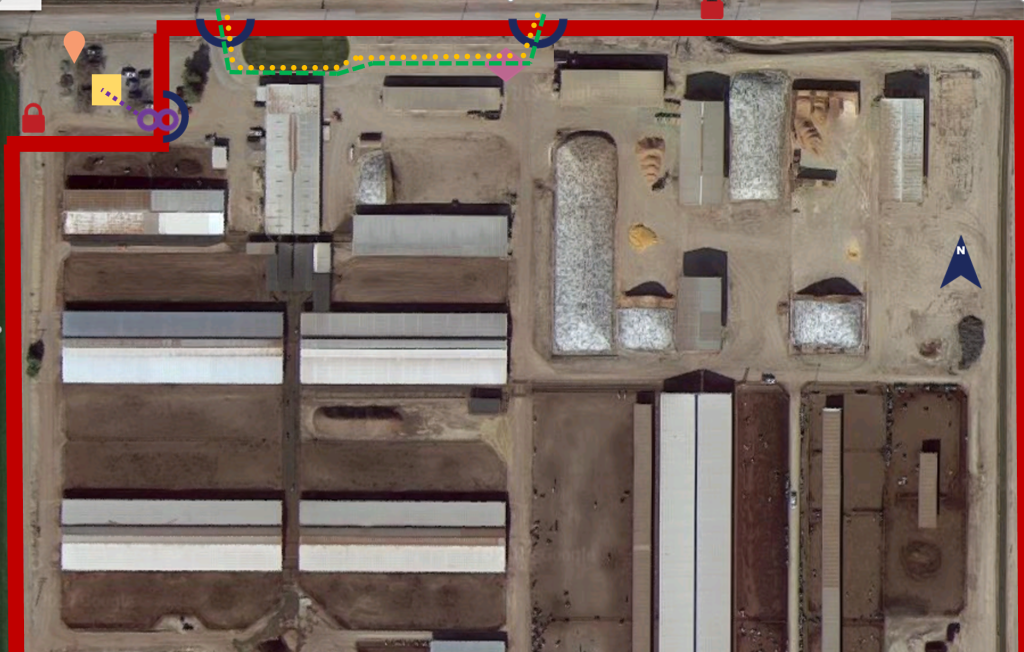
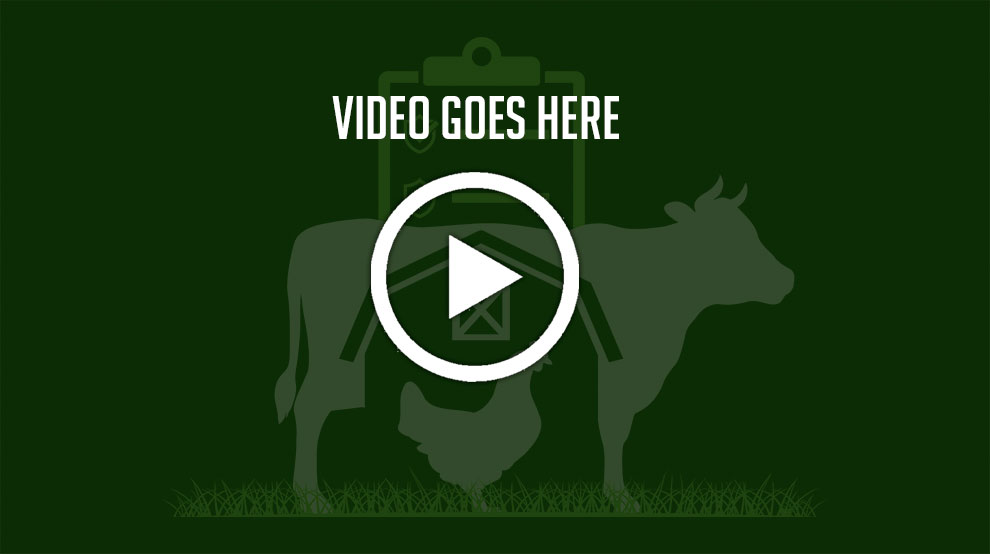
Line of Separation
Line of separation (LOS) is a functional line or barrier separating the cleanest/highest biosecure area on the premises (e.g. poultry houses) from the less clean areas of the Perimeter Buffer Area (PBA) separating the poultry from exposure to potential disease sources. The location and number of LOSs on the premises may vary depending on the type of poultry house (e.g. environmentally secured versus open sided) and the arrangement of houses (e.g. clustered versus spread out).
Generally, if the premises have environmentally secured poultry houses classified into individual biosecure unit(s), then the LOS is defined by the walls of each poultry building with practical deviations to account for entry points, structural aspects, or outside access areas. For poultry kept in open-sided houses or in outdoor pens, the LOS can be established around a cluster of houses or outdoor pens. For examples, see maps below.
Premises maps are essential to visually illustrate your premises biosecurity practices as described in this document. At a minimum, you must include at least three maps for DAILY AND ENHANCED BIOSECURITY.
Daily Biosecurity
Requirements:
- The site-specific biosecurity plan should describe and illustrate on a map the boundaries of the LOS(s) and clearly outline the procedures to be followed when caretakers, visitors, suppliers, or equipment cross the LOS or move among different LOS
- Each map should have its own legend with the information shown in the example legend. Some additional optional maps may be included to support the information provided in the plan.
Premises Maps (Examples):
At a minimum, you will need to have at least three (3) maps of your premises:
- Birds Eye View
- Premises Structures
- Daily Biosecurity Measures*
* IF your daily biosecurity meets the standards of the enhanced biosecurity requirements, you can use one map to cover Biosecurity measures, if not then please provide properly labeled maps. You may submit more maps and may choose to split the above minimum into different maps to demonstrate all the necessary components outlined within the legends.
Please create and submit the maps as a separate document.
A map tutorial video showing step-by-step how to create the maps can be found in the CDFA resources section of the webpage: https://www.cdfa.ca.gov/ahfss/SecureFoodSupply.html An editable word document for map creation can be emailed to you if you contact sfspermitting@cdfa.ca.gov .
Image 1: Bird’s Eye View
This image provides the context to premises orientation including information about nearby premises and risk areas such as bodies of water, poultry premises, feed mills, etc. Include three parcels out from your premises, identify major crossroads, topography of the area, relevant premises or potential risk areas.

Image 2: Premises Structures
This image allows identification of all the structures on the premises.

Image 3: Daily/Enhanced Biosecurity Measures
This image illustrates the layout of premises and detailed information about the biosecurity measures. Please include the items listed in the legend to identify biosecurity measures and traffic flows on your premises.

Describe or reference the map where the LOS are located during normal, daily operations:
For poultry farms with closed sides
A line of separation surrounds each closed poultry house. Each LOS is indicated on the premises map by a yellow box/line.
For poultry farms with open sides
The open-air housing structures on this operation do not provide sufficient separation between groups of animals to justify internal lines of separation between poultry housing units.
Describe how the LOS are visibly indicated (physical barrier, signage) during normal, daily operations:
For poultry farms with closed sides
Signage stating “Authorized Employees Only” is posted in English and Spanish at each door to each house. Each door is locked with a key pad. Only authorized employees have the key pad code.
For poultry farms with open sides
While not a formal LOS, Signage stating “Authorized Employees Only” is posted in English and Spanish at each door to each house.
Describe or reference the map where the Access Points for each LOS are located during normal, daily operations:
For poultry farms with closed sides
Access points for people for each LOS are the single doors located at the south end of each house. Each access point is indicated on the premises map red padlock icon.
For poultry farms with open sides
While not a formal LOS, entry to the houses are by the single doors located at the south end of each house. Each access point is indicated on the premises map red padlock icon.
Describe who can cross each LOS during normal, daily operations:
See above. Only authorized employees have the key pad code. Authorized employees are those performing assigned duties in the house.
Provide the specific standard operating procedure (SOP) for PEOPLE crossing the LOS during normal, daily operations (i.e. use of PPE, foot bath, hand sanitizer, etc.):
Only employees and visitors who have donned appropriate farm-specific PPR (clean coveralls and rubber boots) and have used the footwear disinfections station and hand sanitation station at the LOS access point will enter. Visitors must be accompanied by an authorized employee.
Provide the specific procedures (SOP) for EQUIPMENT crossing into the LOS during normal, daily operations:
Equipment entering the house will remain there until the house is decommissioned during clean-out, which happens about twice a year. If equipment does need to be removed from the house it is cleaned and disinfected before removal.
Provide the procedures (SOP) to prevent cross contamination when PEOPLE move among poultry houses during normal, daily operations:
See above. Employees utilize footwear disinfection stations and hand sanitizing stations at each LOS access point prior to entry.
Provide the procedures (SOP) to prevent cross contamination when GENERAL EQUIPMENT (not egg collection equipment) is moved among poultry houses during normal, daily operations:
Equipment entering the house will remain there until the house is decommissioned during clean-out, which happens about twice a year. If equipment does need to be removed from the house it is cleaned and disinfected before removal. Light/small equipment will be C&Ded at the footwear disinfection station. Heavy equipment & vehicles will be C&Ded at the
Provide the procedures (SOP) to prevent cross contamination when EGG COLLECTION EQUIPMENT is moved among poultry houses during normal, daily operations:
Our farm is an in-line operation with egg collection belts in each house depositing eggs on a conveyor that transports the eggs to a Farm Packer. All eggs packed are nest run. The farm does not have the ability to clean and sanitize the eggs prior to shipment to the processor. Currently, the eggs are being cleaned at the egg processing company. During a prolonged outbreak, IMT can cease this process and permitting requirements should be followed.
Enhanced Biosecurity
LOS Requirements:
- The site-specific enhanced biosecurity plan should describe and illustrate on a map the boundaries of the LOS(s) and clearly outline the procedures to be followed when caretakers, visitors, suppliers, or equipment cross the LOS or move among different LOS during enhanced biosecurity plan activation.
- All LOS must have a clearly marked and identifiable Access Point(s).
- All LOS Access Points must have a dedicated Personal Protective Equipment (PPE) station, footwear disinfection station, and hand sanitizing station.
- Accessing the LOS from the PBA requires at a minimum a change of PPE, use of footbath, and use of hand sanitizer.
- Access across the LOS should be restricted to essential personnel only.
Describe where the LOS are located during Enhanced Biosecurity Plan activation:
See above. No change from procedures described in the “Daily Biosecurity” section.
Describe how the LOS are visibly indicated (physical barrier, signage) during Enhanced Biosecurity Plan activation:
See above. No change from procedures described in the “Daily Biosecurity” section.
Describe or reference the map where the Access Points for each LOS are located during Enhanced Biosecurity Plan activation:
See above. No change from procedures described in the “Daily Biosecurity” section.
Describe who can cross each LOS during Enhanced Biosecurity Plan activation:
See above. No change from procedures described in the “Daily Biosecurity” section.
Provide the procedures (SOP) for PEOPLE crossing into the LOS during Enhanced Biosecurity Plan activation:
In the event of a prolonged outbreak
Provide the procedures (SOP) for EQUIPMENT crossing into the LOS during Enhanced Biosecurity Plan activation:
See above. No change from procedures described in the “Daily Biosecurity” section.
Provide the procedures (SOP) to prevent cross contamination when PEOPLE move among poultry houses during Enhanced Biosecurity Plan activation:
See above. No change from procedures described in the “Daily Biosecurity” section.
Provide the procedures (SOP) to prevent cross contamination for EQUIPMENT (not egg collection equipment) moving among poultry houses during Enhanced Biosecurity Plan activation:
See above. No change from procedures described in the “Daily Biosecurity” section.
Provide the procedures (SOP) to prevent cross contamination for EGG COLLECTION EQUIPMENT moving among poultry houses during Enhanced Biosecurity Plan activation:
See above. No change from procedures described in the “Daily Biosecurity” section.
Line of separation (LOS)
A functional line or barrier separating the cleanest/highest biosecure area on the premises (e.g. poultry houses) from the less clean areas of the Perimeter Buffer Area (PBA) separating the poultry from exposure to potential disease sources. The location and number of LOSs on the premises may vary depending on the type of poultry house (e.g. environmentally secured versus open sided) and the arrangement of houses (e.g. clustered versus spread out).
Access Point
A designated opening in the LOS where specified personnel are permitted to cross by following a specific standard operating procedure (SOP).


